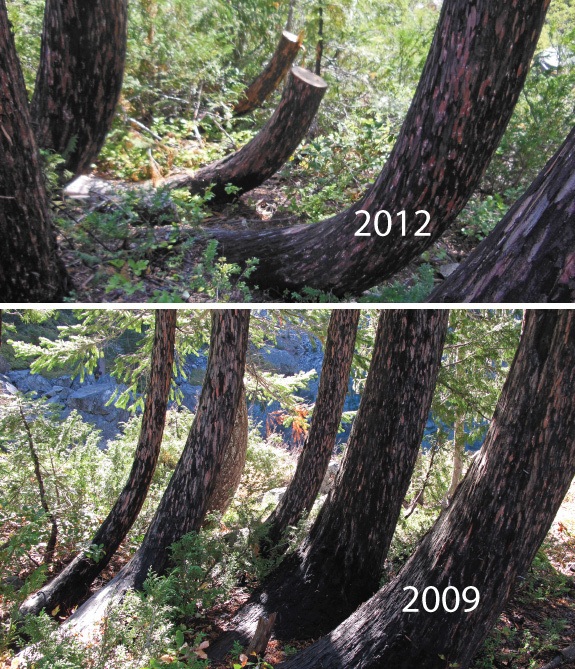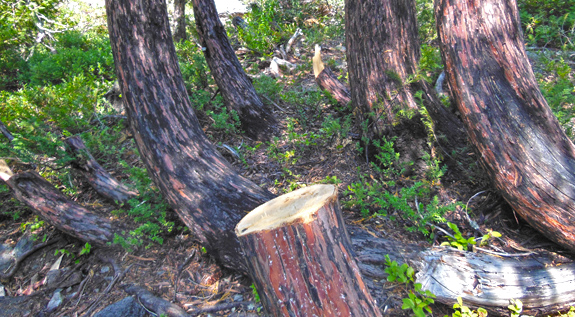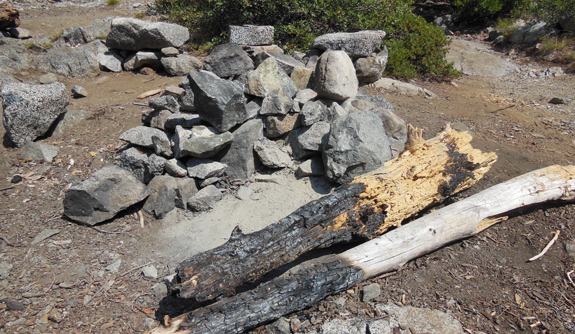Original Publication DATE: 10/27/2012
“Wilderness has a deceptive concreteness at first glance. The difficulty is that while the word is a noun it acts like an adjective. There is no specific material object that is wilderness. The term designates a quality ( as the ‘-ness’ suggests) that produces a certain mood or feeling in a given individual and, as a consequence, may be assigned by that person to specific place. Because of this subjectivity a universally acceptable definition of wilderness is elusive. One man’s wilderness may be another’s roadside picnic… Wilderness, in short, is so heavily freighted with meaning of a personal, symbolic, and changing kind as to resist easy definition.”
—Wilderness and the American Mind, Roderick Nash, third edition; pub. Yale Univ. Press, 1967.
Siskiyou Wilderness | fall 2012
My expectations for wilderness wavers too. As I sit at home with my creature comforts I hope that others are out enjoying the majesty of the wilds–connecting with the natural world and progressing as stewards. When my turn comes to plan a wilderness adventure, destinations are chosen based on where I will find solitude. This was the original, anthropocentric idea behind wilderness–a place that would retain primeval character and guarantee solitude. I am a proponent for more people visiting wilderness (walking in under their own power) so that they might have more authentic experiences in nature, care more, and develop a closer connection to the Earth.
The antithesis of these emotions occurs when wilderness is overused and become banal destinations for ‘extreme’ experiences (and a night of partying). These visitors are often drawn to wilderness through primordial emotions that stir a wanderlust for re-connecting with wild places but those emotions are never realized. Instead, disrespectful actions (probably also common for these folks when they are in syphilization) are the norm. Arriving for a short time they take (while often leaving scars on the landscape or trash for others to remove). Sliding down the surface of things the interconnectedness with primordial places is never found. Even in my short time on Earth, have seen wilderness degraded by “extreme-o-philes” (now with Go-Pro cameras strapped to their heads or cars so they never forget and hopefully never return).

It got personal this summer when one of the rarest conifers in California took a saw to the trunk and I heard the cry. I got word from both Jacob Pounds and Joe Gillespe. Joe has been travelling to the Punchbowl for 40 years and what follows are his reflections in text and pictures.
“Several rare Alaska Yellow-Cedar trees have been cut down for firewood near the edge of Devils Punchbowl in the Siskiyou Wilderness. In a small grove with trees reaching 45 feet tall and 16 inches in diameter, large for these cedars in this the southern-most extent of their range, only twenty feet from the lakes edge, more than a dozen trees as large as 8” in diameter have been cut this past summer.
Devils Punchbowl, a spectacular deep blue lake in a classic glacial cirque, is one of the most popular hiking destinations in the Klamath mountain region. Firewood is scarce here, yet people continue to build large fires when they can find the wood. Over the past ten years or so a large downed sugar pine provided plenty of firewood. Now that scarcity has returned, live trees are targeted, with the small stand of cedar a convenient source.
To make matters worse, in what is a unique botanical area with over 15 conifer species and an exquisite bloom of Lewisia cotyledon, campers continue to build new fire rings by plucking rocks out of the ground. As many as 25 fire rings were counted at this lake alone three summers ago. An association of unique Siskiyou flora are found growing around the edge of each stone, dependent on moisture trapped beneath. These plants wither and die when the stone is removed. The once thriving flora here has taken on a denuded look in recent years.
Once a difficult place to get to with a section of very steep switchbacks, an improved trail makes getting here much easier. The Punchbowl’s popularity has grown, and many who might have been discouraged in the past, now make the six mile trek. Despite Forest Service efforts to encourage people not to camp there and to use “leave no trace” minimum impact camping, the damage, in my opinion, is severe, and begs for more restrictive management.
It is time for Devils Punchbowl to be strictly a No Fire Zone, just as Emerald and Sapphire Lakes in the Trinity Alps, where small signs remind people that fires are not to be built. When it is obvious that users abuse the proper etiquette required to keep this place pristine, the Forest Service must take this next step.“
Joe suggests that we write or call the Happy Camp District Ranger, PO Box 377, Happy Camp, CA 96039-0377 and Klamath National Forest Supervisor, 1711 South Main St., Yreka, CA 96097-9549. Or even to contact him at [jaderiver24 @ yahoo.com] or call 707-954-1641. Lets work together. I’m all in for a Punchbowl rehabilitation project where we get rid of all those stinking fire pits…and do our part to make it wild again.
“But love of the wilderness is more than a hunger for what is always beyond reach; it is also an expression of loyalty to the earth which bore us and sustains us, the only home we shall ever know, the only paradise we ever need – if only we had eyes to see.” –Edward Abbey
This is a video I made in 2009 to share the beauty and slow degradation of the Punchbowl experience.
COMMENT:
AUTHOR: Lauren Lester
DATE: 10/27/2012 7:09:46 PM
criminal act. I don’t get it….
—–
COMMENT:
AUTHOR: hoboroadie
DATE: 6/24/2013 4:36:08 PM
Even if this were not a precious, protected area, the concept of using Yellow Cedar for firewood is beyond the pale. My big dream is to plant a few of them in my Hemlock-Red Cedar forest up by the Skeena, as a gift to future folks.
Heartbreaking, it is.
—–
COMMENT:
AUTHOR: Michael E. Kauffmann
DATE: 6/25/2013 12:32:29 PM
Bummer indeed. But with education, awareness, and stewardship, these sort of acts can be curbed in the future. Thanks for sharing your thoughts – where is the Skeena? I love yellow-cedar, one of my favorite trees.


